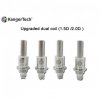K, thanks for that great shot. All in all, a pretty good build. Pulsing will fixit.
Lookin' at a close up of your blow up now. And I'll try to explain this as simply as possible.
First, you're on what I say is the perpendicular with the end turn alignment. That is they terminate in the same direction as they rotate the coil. Looking at the coil from above the legs continue, albeit straight downward, in the same direction as the turn they came off of. Fine, no worries. It's the
straight downward part that causes a problem here.
Straight up and down is susceptible, critically so, to
push up. That can come from simply mounting the tank. A bit of additional pressure on the pin. Even a minute .1mm transmitted directly can push up an end turn. And how? When the lead slips within the grommet.
Why does this happen? Slippery silicone for one. Out of spec pins, another. Too much pressure added in rotation of tightening (it just overcomes all resistance).
The workaround I came up with struggling with the very workable system I'd devised
by the time silicone came out...
EXIT IN ROTATION OF TURN. Obviously then this means a lot more than merely perpendicular termination of the leads. It does. And I'll try and make it clear here.
If you examine your pic, look at the positive termination at the lower left of the coil. Let's call that point 7:00 O'Clock. If the lead continued the turn another 55-60 degrees it would be pointing directly upwards
towards the 11:00 O'Clock of the pin position. Or directly beneath the left center point of that last turn. Likewise with the neg lead which resides at roughly 2:00 O'clock in the pic but should be resting at about 4:30 in this build (given the right shift of this coil).
Now, had the two leads terminated where and as I explain and had you
tightened them firmly by hand or lightly with a forceps the slack would have been taken up and the end turns brought solidly in towards the center of the coil.
Why you ask? If the coil is wrapped with tension it
will strive to pull in. It will only need a little reminder if strain separated it from the rest of the coil during the build.
Pulling it taught across from the vertical position tightens the end turn back in contact with the mandrel lengthening its contact with the surface. I will say tho fiddling can make distortion permanent. If simply setting in the right orientation doesn't get them to lay still where they ought
well, you'll just have to add more tension. In this scenario tighter is better to save the coil.
I resist overly tensioning because it has another distinct implication, lead slip within the grommet. That you'll have to watch out for. And it will manifest itself as a slight deviation in resistance. Often during tank install or resistance check. Maybe something you can live with if it's not too bad but you ended up with a high turn anyway. It happens. Better to take the chance tightening the coil than just accepting the loose turns. A burnt grommet will definitely ruin your vape and juice pretty quickly.
So I'll repeat any significant skew, and this would be one type of example, merits thinking whether to keep the wind. It takes seconds to spin out another and rebuild with a swift cigatron bottom feed.
So sum up, exit at the turn implies
both a perpendicular termination and one where the leads terminate
on the opposite side of the coil from the straight down position. That and a little tension take up the lead slack and consequently the loose end turn.
This my friends can get you that first pulse micro if you get it down pat. And it has to do with our earlier convo cig on tweezing the leads just after wind
in the direction the turn exits the coil while you're prepping it on the bit. And...the resulting
cat's claw "Y" which when inserted will cause the leads to sit on the edge of the assembly cup pretty much where they need to be terminated.
I know it's a lot. But a few times and it's muscle memory.
Good luck cig.





